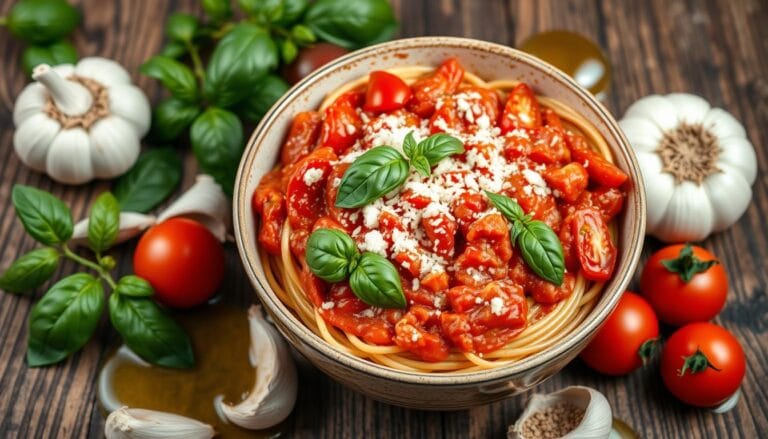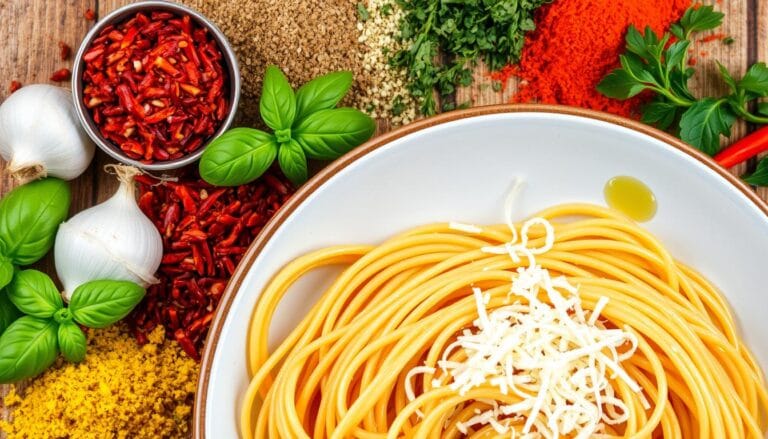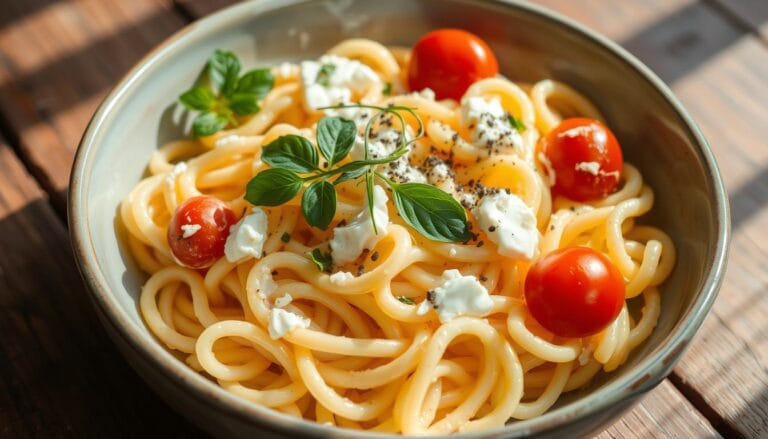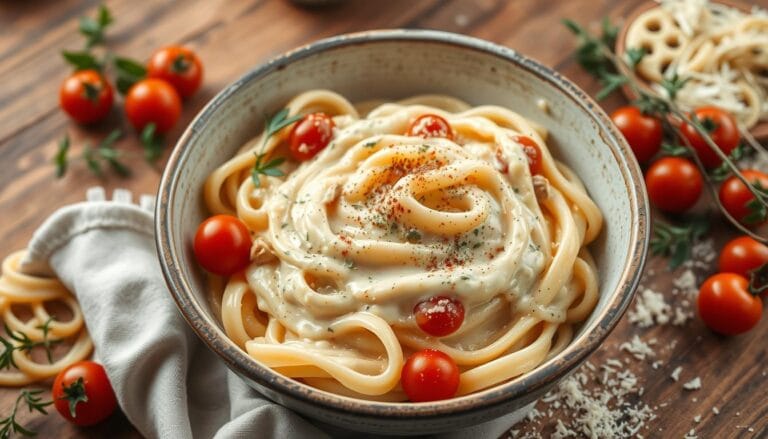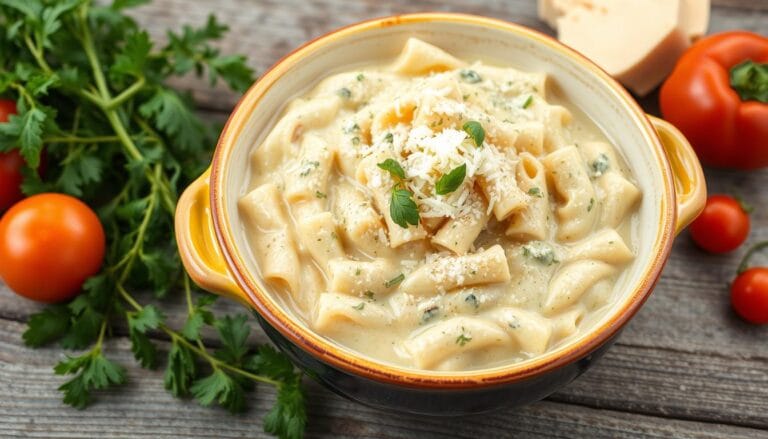Easy Spaghetti Seasoning Recipe
Table of Contents
I love cooking at home and believe the key to a great pasta dish is the right mix of herbs and spices. That’s why I’m excited to share my favorite spaghetti seasoning recipe. It’s a flavorful blend that will make your homemade sauces taste like they’re from Italy.
This homemade spaghetti seasoning recipe is a game-changer. It combines garlic powder, onion powder, oregano, basil, rosemary, thyme, black pepper, sage, and a bit of red pepper flakes and fennel seeds. With just a few ingredients, you can make a blend that adds depth to your pasta dishes, from marinara to Bolognese.
What I love most is how easy and versatile it is. It only takes 5 minutes to make a batch that lasts for a while. You can use it many times, and it stays fresh for up to 6 months in an airtight container. Whether you’re cooking for your family or a dinner party, this blend will make your spaghetti taste like it’s from a restaurant.
Why You Need a Homemade Spaghetti Seasoning recipe Mix
A homemade spaghetti sauce seasoning is key to making tasty spaghetti sauce. It can make both homemade and store-bought sauces better. It’s great for quick dinners or avoiding preservatives in mixes.
One big plus of homemade seasoning is you can change it to fit your taste. You can adjust herbs, spices, and more to match your sauce. This lets you try different flavors until you find the one your family loves.
Also, making your own seasoning saves money. It’s cheaper than buying mixes, and you can make more to save for later. This way, you always have a flavorful mix ready for your spaghetti.
In short, a homemade spaghetti sauce seasoning makes pasta dishes better. It’s easy to customize and saves money. It’s a must-have for anyone who loves making tasty Italian meals at home.
Essential Ingredients for Your Italian Spice Blend
To make the perfect Italian spice blend for spaghetti or other Italian dishes, choose the right herbs and aromatics. This blend adds authentic Mediterranean flavors to your meals.
Dried Herbs and Their Role
The dried herbs are the heart of an Italian spice blend. Basil, oregano, rosemary, thyme, and sage are key. They each bring their own unique aroma and flavor, blending into a perfect mix.
- Basil has a sweet, slightly peppery taste.
- Oregano adds an earthy, minty flavor.
- Rosemary brings a pine-like taste.
- Thyme adds a lemony warmth.
- Sage offers a savory, peppery undertone.
Powdered Aromatics
Powdered aromatics like garlic and onion powder are also key in the Italian spice blend. They add depth and complexity, making the flavor richer.
Optional Heat Elements
Adding a bit of heat can spice up the Italian spice blend. Black pepper gives a subtle kick. Crushed red pepper flakes add more heat, great for those who like it spicy.
The secret to a great Italian spice blend is finding the right balance. Mix earthy herbs with savory aromatics and a hint of heat. This creates a flavor that truly captures the essence of Italian cuisine.
The Secret Behind Perfect Spaghetti Seasoning Recipe
The secret to the best spices for spaghetti sauce is finding the perfect mix. It’s all about balancing classic Italian herb blend flavors with aromatic spices. The recipe combines oregano and basil with rosemary for a unique Italian taste.
Fennel seeds add a special touch, giving the blend a licorice-like flavor. This unique twist makes the seasoning stand out, adding depth to your pasta dish.
You can also add red pepper flakes for extra heat. This makes the seasoning perfect for everyone, no matter their taste. It’s a must-have in any kitchen.
This blend of herbs and spices is made to go well with tomato-based sauces. It brings the authentic Italian flavors you love to your spaghetti. Whether you make your own marinara or use a store-bought sauce, this seasoning will take your pasta to the next level.
Preparing this Italian herb blend takes just a few minutes. It adds complexity and depth to your spaghetti dishes. You can use it not just for spaghetti but also in lasagna, baked ziti, and more.
Step-by-Step Mixing Instructions
Making your own spaghetti seasoning recipe is easy and rewarding. Start by mixing all the ingredients in a small bowl. Make sure to measure each spice carefully for even flavors in your dishes.
Measuring and Combining
First, measure out the dried herbs like basil, oregano, and thyme. Also, add powdered aromatics like garlic and onion powder. If you like a little heat, add crushed red pepper flakes or ground cayenne pepper. Stir well to mix the flavors evenly.
Storage Preparation
After mixing, put the seasoning in an airtight container. A sealed glass jar or small mason jar works great. This keeps the spices fresh. Before using, shake the container well to mix the flavors.
This easy guide helps you make your own how to make spaghetti seasoning recipe at home. Your homemade spice blend will make your spaghetti dishes taste amazing. You can adjust the flavors to your liking.
Understanding Each Spice Component
Creating the perfect spaghetti spice blend means knowing each ingredient’s role. This Italian seasoning ingredients mix is like a symphony of flavors. Each spice and herb adds its own special note.
Garlic and onion powders give a rich, savory base. They add depth and complexity. Oregano, basil, rosemary, thyme, and sage bring the true Italian taste. They make you feel like you’re in the Mediterranean.
Black pepper boosts the blend’s taste. Optional red pepper flakes add a gentle heat. Fennel seeds bring a unique flavor, like licorice, that goes well with the other ingredients.
- Garlic and onion powders: Provide savory depth and umami notes.
- Oregano, basil, rosemary, thyme, and sage: Contribute classic Italian herb flavors.
- Black pepper: Enhances overall taste and aroma.
- Red pepper flakes (optional): Add a subtle hint of heat.
- Fennel seeds: Offer a unique, licorice-like aromatic quality.
Knowing how each part works in the spaghetti spice blend helps you customize it. By understanding the Italian seasoning ingredients, you can adjust the flavors to your liking. This way, you can make a truly amazing spaghetti seasoning recipe.
“The secret to a great spaghetti sauce lies in the perfect balance of herbs and spices.”
Proper Storage and Shelf Life
Storing your homemade spaghetti seasoning recipe right is crucial for keeping it fresh and tasty. The trick to making your spice blend last longer is in the storage container and the environment.
Container Selection
For the best storage, use an airtight container like a glass jar or small mason jar. Stay away from plastic bags or containers because they let air and moisture in. Glass jars block out air and moisture, keeping the spices fresh.
Environmental Factors
Where you store your storing spaghetti seasoning recipe matters a lot. Put the container in a cool, dry spot, away from sunlight. Heat, humidity, or light can make the herbs and spices lose their flavor and strength faster.
With proper storage, your homemade spice blend shelf life can go up to 6 months. Always use a clean, dry spoon to avoid moisture, which can cause clumps or spoilage.
“Proper storage is the key to preserving the freshness and flavor of your homemade spaghetti seasoning.”
By sticking to these easy storage tips, your spaghetti seasoning recipe will stay tasty and perfect for your pasta dishes for months.
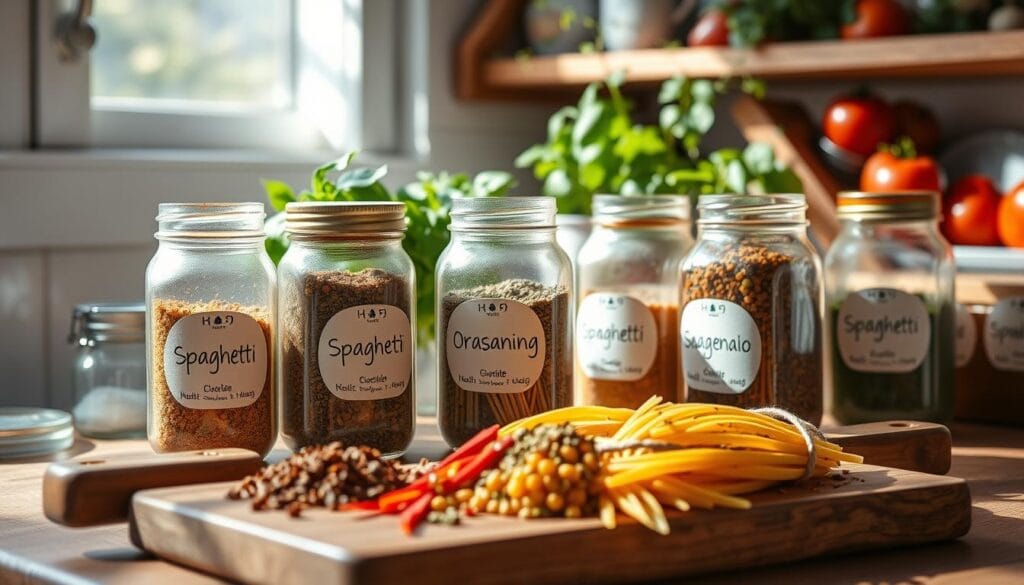
How to Use Your Seasoning Blend
Get the most out of your homemade spaghetti seasoning blend. It’s not just for pasta sauces. You can also use it to make store-bought pasta sauce flavoring taste better.
Begin by adding 2-3 tablespoons of the seasoning to each batch of pasta sauce (about 4 cups). Shake the container well before each use. This ensures the herbs and spices are mixed evenly. You can adjust the amount to suit your taste, adding more or less for the flavor you want.
But it’s not just for pasta sauces. You can also use it to boost the flavor of pizza sauces, garlic bread, and other Italian dishes. Just sprinkle it on top or mix it into your recipe.
| Dish | Spaghetti Seasoning Usage | Quantity Recommendation |
|---|---|---|
| Homemade Pasta Sauce | Add directly to the sauce | 2-3 tablespoons per 4 cups of sauce |
| Store-Bought Pasta Sauce | Mix into the sauce | 2-3 tablespoons per 24-ounce jar |
| Pizza Sauce | Sprinkle on top or mix in | 1-2 tablespoons per 12-inch pizza |
| Garlic Bread | Sprinkle on top before baking | 1 teaspoon per loaf |
Remember, the secret to using your spaghetti seasoning blend is to adjust the amount. Start with the recommended amounts and then adjust to your liking. This way, you’ll get a truly flavorful Italian-inspired meal.
Tips for Customizing Your Blend
Homemade spaghetti seasoning is all about being flexible. Once you get the basic recipe down, start playing with it. You can tweak the heat or try new herbs to match your taste.
Adjusting Heat Levels
Want a bit more heat? Add more red pepper flakes. Start with 1/4 teaspoon and add more until it’s just right. Or, skip the red pepper flakes if you don’t like spicy food.
Herb Substitutions
While oregano, basil, and thyme are key, you can mix it up. Try parsley, marjoram, or rosemary for a unique flavor. Just remember to keep it Italian.
For a smoother blend, grind it in a spice grinder or food processor. This makes it finer and more even.
As you tweak your seasoning, taste it often and adjust. Keep track of your changes so you can make it again. Making your own blend lets you make your spaghetti dishes truly yours.
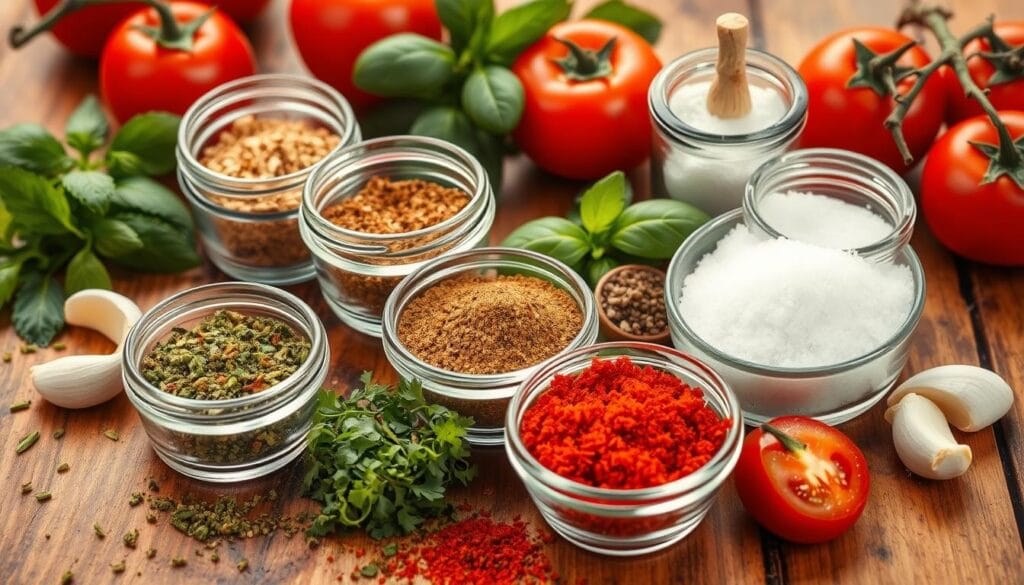
Common Mistakes to Avoid
Creating the perfect spaghetti seasoning requires avoiding a few common mistakes. First, don’t add salt directly to your spice blend. This can make your dish too salty. Instead, use the natural saltiness from ingredients like garlic powder or onion powder.
Another mistake is using fresh herbs in your seasoning mix. Fresh herbs may taste great at first but lose flavor quickly. Choose dried herbs, which keep their flavor longer. This ensures your seasoning stays tasty even after storage.
- Avoid storing your spaghetti seasoning near heat sources or in humid environments, as this can cause the spices to lose their aroma and potency over time.
- When scooping the seasoning, make sure to use dry utensils to prevent any moisture from being introduced, which can lead to clumping and a less cohesive blend.
- Remember to label your seasoning containers with the date of preparation to keep track of their freshness and know when it’s time to whip up a new batch.
By avoiding these common spaghetti seasoning tips and spice blend errors, you’ll make a flavorful and lasting spice blend. This will take your spaghetti dishes to new heights.
Enhancing Store-Bought Sauce
Make your store-bought spaghetti sauce taste better with a simple trick. Add 1-2 tablespoons of your homemade spaghetti seasoning mix. This will greatly enhance the flavor and make it taste homemade.
Proper Ratios
Start with a small amount of seasoning and add more as needed. Begin with 1 tablespoon of your blend in the jar. Stir it well and taste. If it’s not flavorful enough, add another 1 tablespoon.
Adjust the seasoning to your liking. This way, you can get the perfect taste for your sauce.
Timing of Addition
For the best flavor, add the seasoning at the start. This lets the flavors mix well as the sauce heats up. For an even richer taste, add some seasoning at the beginning and the rest towards the end.
This method ensures all spices are well mixed. It helps the sauce reach its full flavor.
By adding your homemade spaghetti seasoning, you can turn a basic sauce into a delicious homemade-tasting one. This trick can make your pasta dishes taste like they were made from scratch.
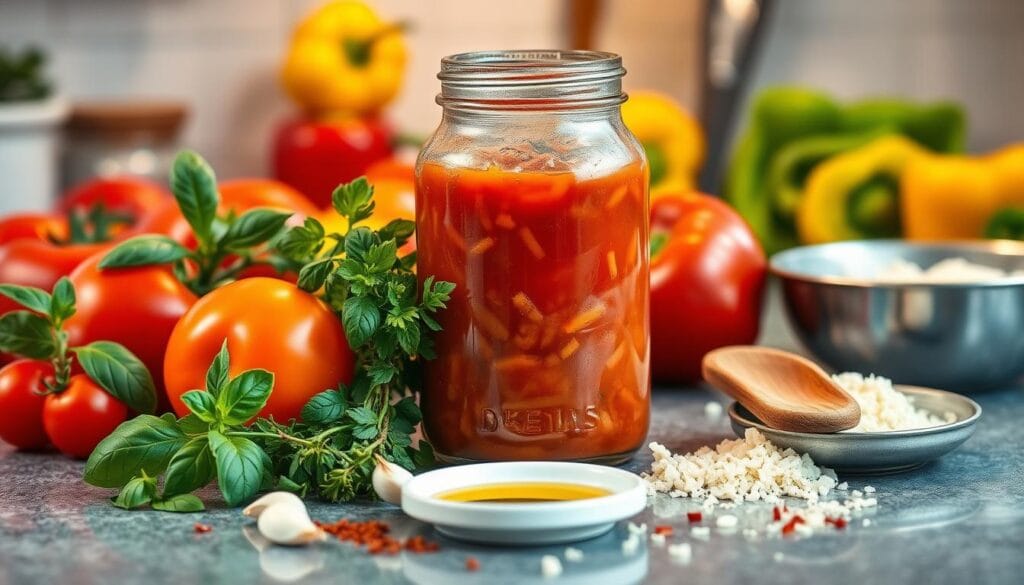
Beyond Pasta: Creative Uses
Your homemade Italian seasoning blend is more than just for pasta. It can make many dishes taste better. Try it in different recipes to see how it changes them.
Elevate Your Breads and Baked Goods
Add your Italian seasoning uses to bread dough or pizza crust. It brings real Italian taste to your baked goods. From loaves to dinner rolls, it makes everything better.
Seasoned Meatballs and Lasagna
Use your seasoning in meatballs or lasagna. It adds a special flavor that goes well with the dish. This makes the taste of the dish even better.
Flavor-Packed Bruschetta and Dipping Sauces
Make bruschetta with tomatoes, garlic, and basil and your seasoning. Or mix it with olive oil for a tasty dipping sauce. Both are delicious.
Spice Up Soups and Roasted Veggies
Add your Italian seasoning uses to soups or roasted veggies. It gives them a strong Italian taste. Try it with zucchini, bell peppers, and eggplant.
Seasoned Pizza Toppings
Make your pizza better by adding the seasoning to toppings. It works well with mushrooms and onions. It’s perfect for any Italian dish.
Use your versatile spice blend in many recipes. It’s great for main dishes, baked goods, and more. Let it add depth to your cooking.
Making Bigger Batches
Do you often make homemade spaghetti seasoning? Scaling up the recipe can be a good idea. Doubling or tripling the ingredients means you’ll have more to use. Plus, it can save you money.
Scaling Tips
When you make more seasoning, keep the spice and herb ratios right. This keeps the flavor the same, even in bigger batches. Make sure to mix everything well so the flavors spread evenly.
Cost Benefits
Making bulk spaghetti seasoning recipe can save you money. Buying more ingredients at once often means paying less per unit. This makes your homemade spice mix cheaper than store-bought. Plus, you won’t have to mix it as often, saving you time.
FAQ
What are the key ingredients in a homemade spaghetti seasoning recipe?
Homemade spaghetti seasoning recipe includes dried herbs like oregano, basil, and rosemary. Thyme, sage, garlic powder, and onion powder are also key. Black pepper and red pepper flakes are optional, along with fennel seeds.
What makes a homemade spaghetti seasoning recipe better than store-bought?
Homemade seasoning is customizable and cheaper. It doesn’t have preservatives found in store mixes. You can adjust the ingredients for better flavor and versatility.
How do I properly store the spaghetti seasoning recipe to maintain freshness?
Keep the seasoning in an airtight container, like a glass jar. Store it in a cool, dry place, away from sunlight. This keeps the spices fresh for up to 6 months.
How much spaghetti seasoning recipe should I use in my pasta sauce?
Use 2-3 tablespoons for a standard sauce batch (about 4 cups). Adjust to taste and recipe size.
Can I customize the spaghetti seasoning recipe blend to suit my tastes?
Yes, you can adjust the blend to your liking. Change the red pepper flakes for heat or try different herb ratios. Add herbs like parsley or marjoram for your taste.
What are some common mistakes to avoid when making and using spaghetti seasoning recipe?
Don’t add salt to the blend to avoid over-salting. Use dried herbs for longer shelf life. Store it away from heat and moisture. Use dry utensils to scoop the seasoning.
How can I use the spaghetti seasoning beyond pasta dishes?
Use the seasoning in many Italian dishes. Add it to bread, meatballs, or lasagna. Sprinkle it on bruschetta or in soups. Mix it with olive oil for a bread dip.


